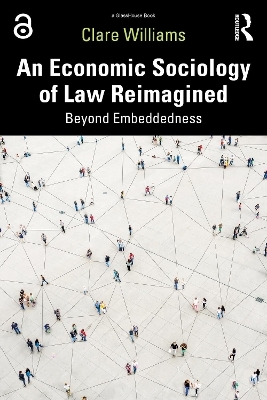
An Economic Sociology of Law Reimagined
Routledge (Verlag)
978-1-032-42022-6 (ISBN)
This book critically examines the concept of “embeddedness”: the core concept of an economic sociology of law (ESL).
It suggests that our ways of doing, talking, and thinking about law, economy, and society, reproduce and re-entrench mainstream approaches, shaping our thoughts and actions such that we perform according to the model. Taking a deep dive into one example – the concept of embeddedness – this book combines insights from law, sociology, economics, and psychology to show that while we use metaphor to talk about law and economy, our metaphors in turn use us, moulding us into their fictionalized caricatures of homo juridicus and homo economicus. The result is a groundbreaking study into the prioritization throughout society of interests and voices that align with doctrinal understandings of law and neoclassical understandings of economics: approaches that led us into the dilemmas currently facing society. Zooming out from a detailed exploration of embeddedness in economic sociology and ESL literature, the book unpacks the fashionable post-2008 claim that the economy should be re-embedded in society and proposes two conceptual shifts in response. The book draws on personas and vignettes throughout, both to imagine and to realize shifting an ESL beyond embeddedness.
This timely engagement with the emerging field of economic sociology of law will appeal to socio-legal scholars and others with interests in the intersection of law, economics, and sociology.
The Open Access versions of Chapter 1 and Chapter 6, available at www.taylorfrancis.com, have been made available under a Creative Commons Attribution-Non Commercial-No Derivatives 4.0 license.
Clare Williams is an ESRC—SeNSS funded Postdoctoral Research Fellow at Kent Law School, University of Kent, UK.
Preface
Acknowledgements and return journeys
Visualizing socio-legal frames, concepts, and methods
1 Doing, talking, and thinking (and why we’re not getting it right)
Crashes, crises, catastrophes
Doing, talking, and thinking
The law and the economy don’t really exist
PS: Nor does society
How metaphors use us
Constructing reality
Introducing homo juridicus and homo economicus
An ongoing conceptual commitment to embeddedness
Introducing an economic sociology of law (ESL): the home of embeddedness
The career of embeddedness in ESL and two conceptual conundrums
Embeddedness in academic literature: drawing parallels and drawing conclusions
Introducing our “guide” personas: Ann, Polly, and Lillian
Bibliography
2 Introducing an economic sociology of law
What is an economic sociology of law (ESL)?
The role of economic sociology of law: responding to disciplinarity
The intellectual heritage of ESL: economic sociology and socio-legal scholarship
Socio-legal heritage
Economic sociology heritage
“Black boxes” and taxonomies
Text; subtext; context
Empirical; conceptual; normative
Econo-socio-legal
Instrumental; affective; belief-based; traditional
Micro; meso; macro; meta
Writing the rules of the game: indicators as technologies of governance
ESL is (currently) a pseudo-constructivist lens: boundaries and borderlands
Bibliography
3 Embeddedness: A biography of a concept
Embeddedness: the origins
Talking about embeddedness
Karl Polanyi’s always (or never) embedded market
The “accidental” revival of embeddedness
Critiques of embeddedness
Critiques of macro-level embeddedness
Critiques of micro-level embeddedness
Reconciling macro- and micro-level embeddedness?
Reconciling the implications: cognitive and normative embeddedness
How might we make embeddedness more consistent?
Embedded liberalism
Embedded autonomy
Reconciling the insights?
The embeddedness conundrum is reinvented
Bibliography
4 Embeddedness: The internal inconsistencies
The internal inconsistency of embeddedness: “what are we talking about?”
Block’s interpretation of Polanyian embeddedness
Dale’s interpretation of Polanyian embeddedness
Doughnut Economics versus The Econocracy
Doughnut Economics
The Econocracy
Emblematic of a wider approach
What is embedded? And in what?
Bibliography
5 Embeddedness: The external conceptual incompatibilities
How we tend to think (our default conceptual tools)
How we might think differently (challenging default conceptual tools)
Thinking about embeddedness as a black box
Proposing an alternative ESL lens: beyond embeddedness
Shift 1: from the actor to their interaction
Trust is important in understanding interactions
Shift 2: embeddedness to feedback loops
Understanding feedback loops through performativity
Exploring the performativity of law and economics with a thought experiment
Beyond homo economicus-juridicus?
Bibliography
6 Beyond embeddedness: The next steps
What remains of ESL without its core concept of embeddedness?
Lingering questions about an ESL lens
What, where, or who is “the social”?
But “how much?”: the “sociological fallacy”
Removing the core concept: what is left?
What’s in a name? Linguistic limitations
Clean models or dirty hands?
ESL, politics, and power: can an ESL lens ever be apolitical?
Responding to crashes, crises, catastrophes
Our conceptual commitment to embeddedness continues
Shoehorning concepts into categories: Happy the Elephant, Chucho the Bear, and their friends
Shoehorning concepts into categories: COVID versus the economy?
Rebalancing voices and values: becoming ‘homo sociologicus’?
“Happy” Bhutan
“Sustainable” Oslo
Framing the future? Rebalancing voices and values
Moving beyond embeddedness?
Bibliography
Epilogue: Notes about the characters
Index
| Erscheinungsdatum | 07.12.2022 |
|---|---|
| Zusatzinfo | 3 Tables, black and white; 10 Line drawings, black and white; 9 Halftones, black and white; 19 Illustrations, black and white |
| Verlagsort | London |
| Sprache | englisch |
| Maße | 156 x 234 mm |
| Gewicht | 700 g |
| Themenwelt | Recht / Steuern ► Allgemeines / Lexika |
| Recht / Steuern ► EU / Internationales Recht | |
| Recht / Steuern ► Wirtschaftsrecht ► Gesellschaftsrecht | |
| Wirtschaft ► Allgemeines / Lexika | |
| Wirtschaft ► Volkswirtschaftslehre | |
| ISBN-10 | 1-032-42022-7 / 1032420227 |
| ISBN-13 | 978-1-032-42022-6 / 9781032420226 |
| Zustand | Neuware |
| Informationen gemäß Produktsicherheitsverordnung (GPSR) | |
| Haben Sie eine Frage zum Produkt? |
aus dem Bereich


